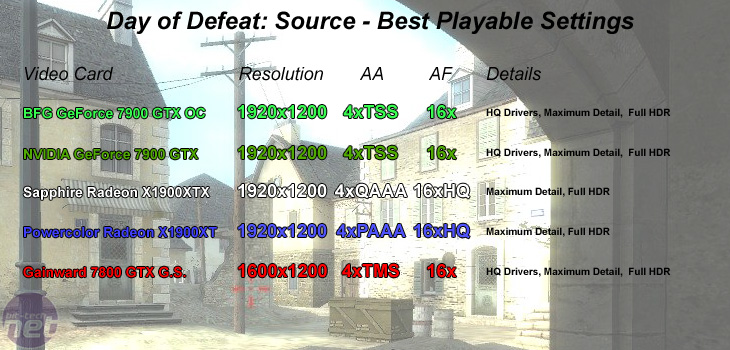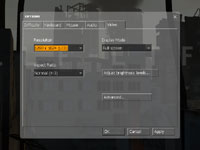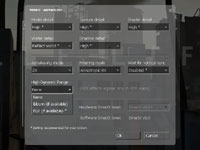Day of Defeat: Source
Publisher: ValveWe used the popular remake of the World War II online multiplayer, Day of Defeat: Source, which uses Valve's implementation of high-dynamic range rendering. We did three five minute portions of real world game play on the dod_anzio map. We connected to three different public servers each with a ping of less than 30ms and 16-20 players in the game when we were recording the frame rates.
Anti-Aliasing and Anisotropic Filtering were controlled from inside the game, and thus the drivers were left set to "Application Controlled". There are three options for the method of HDR used in this title. You can either disable HDR completely, make use of "Bloom" which is just what it says and less resource hungry in comparison to "Full" which, again is just what it says. It utilises a full dynamic range with the iris effect too.
We have written quite a bit about Half-Life 2: Lost Coast, Day of Defeat: Source and how Valve have implemented HDR in to the Source Engine. You can check out the articles listed below for more information on The Lost Coast & Day of Defeat: Source.
- Half-Life 2: Lost Coast HDR overview
- Half-Life 2: Lost Coast hands on
- Half-Life 2: Lost Coast Benchmarks & Video
- Day of Defeat: Source
- Cinematic Effects in Source


This is because we're already running at close to the maximum settings available to the game. However, there were some improvements in the frame rates delivered, with the most notable being the 4 fps increase in minimum frame rate. Aside from the increase in frame rate, there was no difference in playability, as the GeForce 7900 GTX (at both frequencies) never dropped below 35 frames per second. The only increase in image quality would be to enable 8xSAA, which eats frame rate for breakfast, lunch and dinner on a single card.
The Radeon X1900XTX was playable at similar settings with the addition of the high quality anisotropic filtering setting. This did help to improve the image quality somewhat, as there were some areas that did appear to lack anisotropic filtering on NVIDIA's GeForce 7900 GTX. The Radeon X1900XT was playable at the same resolution, but we found that we had to lower the adaptive antialiasing quality from quality to performance in order to maintain frame rates high enough for multiplayer gaming.

MSI MPG Velox 100R Chassis Review
October 14 2021 | 15:04








Want to comment? Please log in.